Accelerated Infliximab Induction for Severe Lower Gastrointestinal Bleeding in a Young Patient with Crohn’s Disease:A Case Report
INTRODUCTION
Crohn's disease (CD) is a subtype of inflammatory bowel disease (IBD)[1].Severe lower gastrointestinal bleeding (SLGIB) is an uncommon but potentially lifethreatening complication of CD.The incidence of acute LGIB secondary to CD in China ranges from 0.6% to 6%[2].The definition of SLGIB in CD has changed over the years.In 1976,Homan[3] defined it as profuse rectal bleeding that required blood transfusions to maintain normal vital signs.In a recent case series,the definition was again modified to a drop in hemoglobin (Hb) of 2 g/dL below the baseline+/-hemodynamic instability or an abrupt fall in Hb to less than 9[4,5].Monoclonal antitumor necrosis factor (TNF)-α antibody (IFX) can induce relatively fast mucosal healing.It has been reported for the treatment of SLGIB,but there are few reports on the accelerated IFX induction in CD patients with SLGIB.We present a patient with CD complicated with SLGIB.The bleeding was controlled,and colonoscopy showed mucosal healing after accelerated IFX induction.
CASE PRESENTATION
Imaging examinations
Initial colonoscopy on 15 July 2020 revealed multiple areas of inflammation of the colon (Figure 1A) and a sigmoid colon ulcer with bleeding (Figure 1B).Hemostasis was achieved under endoscopy (Figure 1C).Enhanced computerized tomography of the small intestine noted thickened walls of the small intestine and colon on 18 July 2020 (Figures 2A,2B).Pathology revealed acute on chronic inflammation with granulation tissue,compatible with CD.In addition,Cytomegalovirus (CMV)immunohistochemical staining and acid-fast staining were negative (Figures 3A,3B).Colonoscopy on 25 July 2020 showed multiple ulcers with hemorrhage (Figures 4A,4B).After accelerated IFX induction therapy,colonoscopy showed mucosal healing in 8 wk (Figures 5A,5B).

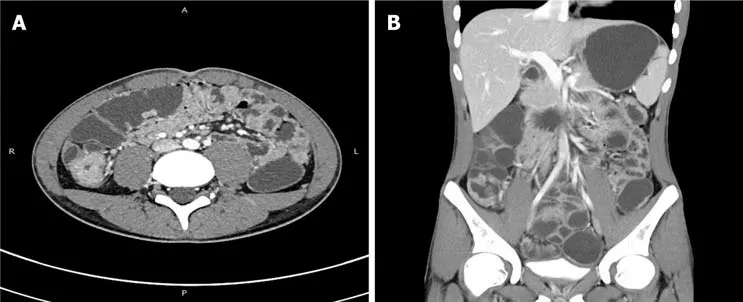
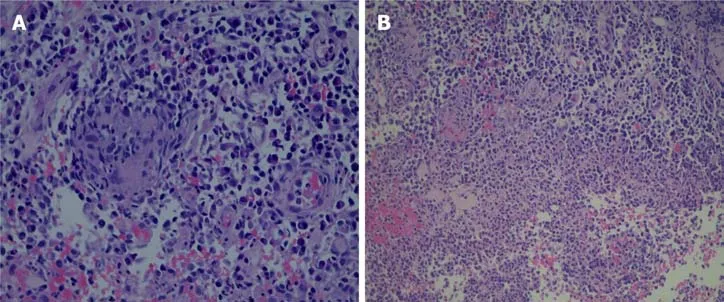
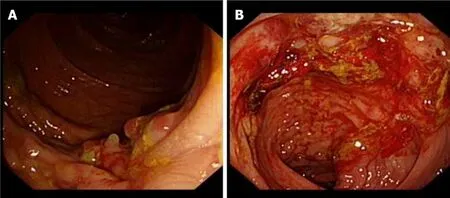
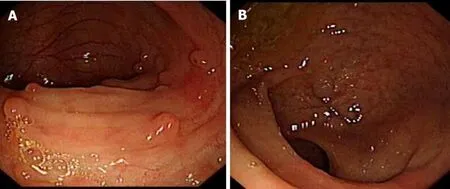
Laboratory examinations
Blood analysis revealed leukocytosis (16.67 × 10/L),with predominant neutrophils
(82%),mild anemia (hemoglobin 11.3 g/dL),and platelets that were increased slightly to 348.0 × 10/L.Serum C-reactive protein content was increased at 123 mg/L (normal range<5 mg/L),and the red blood cell sedimentation rate was 82 mm/h.The fecal calprotectin was increased at 1703.43 µg/g,and both anti-intestinal goblet cell and anti-pancreatic exocrine gland antibodies were positive.Prothrombin and partial thromboplastin time,electrocardiogram and urinalysis were all normal.CMV immunoglobulin (Ig) M,IgG,CMV DNA,Epstein-Barr virus (EBV)-VCA IgM,EBV DNA,human immunodeficiency virus (HIV) antibody (Ab),amoeba antibodies,Clostridium difficile toxin,Salmonella,Shigella cultures,and Campylobacter were all negative.Positive stool pus and occult blood were noted.
From a psychoanalytical viewpoint, the changes that appear in the 1857 version reveal a great deal about Wilhelm {Grimm}. To begin with, the betrayal of the father can be equated81 with Wilhelm s father s early death. The mistreatment of the girl and her helpless condition can be connected to the mistreatment Wilhelm endured in Kassel, his asthma82 and heart troubles. The creation of the Strong angelic figure who helps the girl can be related to Jacob {Grimm}, who constantly stood by Wilhelm and came to his aid. The misunderstandings in the marriage that are patched up by the angel may indicate some difficulties in Wilhelm s marriage with Dortchen Wild that were resolved by Jacob. Finally, the general theme of the story can be summed up by the Grimms family motto: Tute si recte vixeris - he cannot go wrong whose life is in the right. (Brothers, 171)
Physical examination
The patient had a noncontributory previous personal and family history.
Personal and family history
Physical examination on admission showed a body temperature of 36.0 °C,heart rate of 91 bpm,arterial blood pressure of 113/66 mmHg,respiratory rate of 18/min,and oxygen saturation in room air of 100%.Small ulcers could be seen in the mouth and scattered on the lower lip,and small cracks could be seen around the anus.
In order to test the truth of his statement about the dogs, he said at once, Salt, I am hungry, and before the words were out of his mouth the dog had disappeared, and returned in a few minutes with a large basket full of the most delicious food
History of past illness
The final diagnosis of the presented case was SLGIB secondary to CD (Montreal A1L2B1p).The pediatric CD activity index (PCDAI) was 47.5 points.
History of present illness
The patient complained of recurrent periumbilical pain for more than 1 mo with no obvious causes.Appendicitis was suspected in the local hospital,and he received antiinflammatory treatment.However,the periumbilical pain did not improve,and he suffered bloody stool 4 times in the 2 wk before admission.He also mentioned weight loss of 10 kg within 1 year.
Chief complaints
CD is a subtype of IBD,which is characterized by transmural inflammation of the entire intestinal wall,which can lead to various serious complications,including intestinal obstruction,intra-abdominal abscess and intestinal fistula[1].Among them,SLGIB is an uncommon but potentially life-threatening complication of CD.Cirocco[6] reported that the incidence of lower gastrointestinal bleeding (LGIB) in 631 CD patients was 0.6%,while Kim[4] reported that the incidence of LGIB in 1731 CD patients was 4%.In general,the reported incidence of acute LGIB secondary to CD in China ranges from 0.6% to 6% [2,4,7].Li[1] also found that patients with a past medical history of bleeding,lesions involving the left colon,and the use of azathioprine for less than 1 year were all risk factors for acute LGIB in CD patients.Male sex was also found to be a risk factor[8].Mazor[9] and Severs[10] even reported that only male sex was independently associated with complex complications,including stenosis,penetrating lesions and perianal lesions,and a high risk of needing surgical intervention.In our case,the patient was a 16-year-old boy.Therefore,further research may be needed to confirm the influence of sex on acute LGIB in CD patients in the future.
FINAL DIAGNOSIS
He had a history of recurrent oral ulcers for nearly 1 year without special treatment.
TREATMENT
The treatment of CD has developed continuously in recent years,including the use of mesalazine,corticosteroids,and immunosuppressants.For SLGIB in CD patients,surgical treatment was the most commonly chosen treatment strategy in the past;it has a lower rebleeding risk than conservative drug therapy [1,11].However,it was also very difficult to identify the bleeding sites accurately in SLGIB in CD,and the risk of postoperative intestinal obstruction,anastomotic leakage,fistula,and short bowel syndrome was very high[12].In our case,the patient was very young.Considering the large range of lesions and possible postoperative complications,surgical intervention was not considered.In some SLGIB in CD,local injection of adrenaline or thrombin under endoscopy could effectively stop the bleeding[13].However,it is difficult to stop the bleeding under endoscopy if there are multiple bleeding sites with both ileum and colon involvement.In this case,we performed endoscopic homeostasis twice but were unable to stop the bleeding completely.Belaiche[13] found that corticosteroids could be used to treat LGIB in CD patients.However,some studies[4,14,15]reported that the effect of corticosteroids on the treatment of LGIB in CD was not exact and that those receiving corticosteroids were more likely to rebleed.The patient in our case was treated with standard corticosteroid therapy at first,but he still had bloody stool after 1 wk of treatment.
OUTCOME AND FOLLOW-UP
But she could not withstand a desire to see this strange man, so she helped Abdallah to carry up the dishes, and saw in a moment that Cogia Hassan was the robber Captain, and carried a dagger38 under his garment
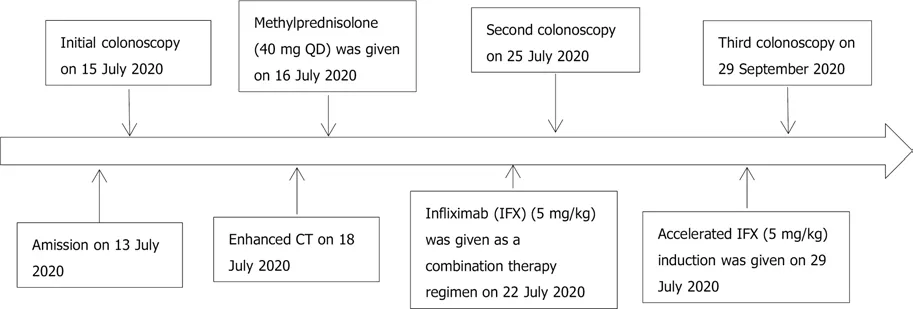
DISCUSSION
A 16-year-old boy presented to the Department of Gastroenterology in our hospital complaining of recurrent periumbilical pain without obvious predisposing causes for more than 1 mo and bloody stool 4 times within 2 wk.
The patient,following the diagnosis of severe CD,was immediately started on methylprednisolone 40 mg QD intravenously combined with nasal feeding enteral nutrition support treatment.IFX (5 mg/kg) was given when uncontrolled bleeding occurred 1 wk after treatment with methylprednisolone on 25 July 2020.The second IFX (5 mg/kg) treatment was given on 1 August 2020 for uncontrolled SLGIB.After 8 wk of treatment,colonoscopy showed mucosal healing.
On 29 September 2020,follow-up colonoscopy showed that the mucosa had healed without any ulcers (Figures 5A,5B).After 8 wk of IFX treatment,the PCDAI was 5 points.Thus far,the bleeding has not recurred.His body weight increased 10 kg,and his height increased 2 cm as of 1 August 2021.The timeline information of this patient was shown in Figure 6.
With the advent of IFX,an increasing number of reports have described IFX for the treatment of CD with acute LGIB with a significant effect.IFX is an anti-TNFα monoclonal antibody that can counteract the TNF-α-mediated intestinal inflammatory response,quickly reduce inflammation of the intestinal wall,promote ulcer healing,and effectively prevent and control the occurrence of bleeding[11].As early as 2003,Papi[16] reported 2 cases of CD patients with recurrent LGIB that achieved mucosal healing after the application of IFX (5 mg/kg),and bleeding did not reoccur.Aniwan[11] also reported 7 cases of LGIB secondary to CD.All patients stopped bleeding after 1-2 rounds of treatment with IFX (5 mg/kg).Therefore,IFX may be an ideal choice for LGIB in CD.
It s where he used to live. Gaston is out in the world and on his own now. You can see for yourself how comfortable he was in there. He had everything.
O Peter, said he, what a sorrow you have caused us, both myself and your mother, by running off like this just as we had got you well educated! Get up, now, so that I can see you properly, and have a talk with you
Nevertheless,there were a large number of patients who did not have a good response to IFX,which might be related to a high drug clearance rate,excessive stool loss,reduced drug exposure,and poor drug response[17,18].For these patients,some studies suggested shortening the IFX infusion time from the recommended 2 h to 1 h to improve the therapeutic effect[19].On the other hand,accelerated IFX induction is increasingly used in moderate to severe ulcerative colitis (UC) patients who do not have a good response to the first IFX induction.In the guidelines,the "accelerated IFX induction (AD IFX)" is when the frequency of administration of IFX during the induction period exceeds the frequency of administration recommended in the latest product monograph[20].AD IFX can better and more quickly control the disease[21].It can reduce the occurrence of early colectomy[22].The decision to use shorter dosing intervals rather than dose escalations is based on the pharmacokinetics of IFX.Therefore,AD IFX has been increasingly used in clinical practice.Since 2014,AD IFX induction in accelerated severe UC patients has been used in clinical practice in the Republic of Ireland,specifically for patients with more severe disease or poor initial response to standard treatment of IFX[21].However,AD IFX is rarely reported to be used in CD patients.In our case,according to the PCDAI,methylprednisolone (40 mg QD) was given intravenously.Unfortunately,he had a large amount of bloody stool again after 1 wk of methylprednisolone treatment,with a rapidly decreasing hemoglobin level.Although IFX (5 mg/kg) was given as a combination therapy regimen,he still had bloody stool,with the hemoglobin level decreasing sharply in a short time as in SLGIB.With informed consent,AD IFX (5 mg/kg) was given 7 days after the first treatment.The bleeding then stopped.Eight weeks after the treatment,colonoscopy showed mucosal healing,the patient was symptom-free,and thus far,no recurrent bleeding has occurred.However,it is worth noting that although Peyrin-Biroulet[23] found that IFX did not increase the risk of death,tumor or serious infection in CD patients through meta-analysis,a clinical study[24] found that the incidence of upper respiratory tract and urinary tract infections in the IFX group and the control group were 36% and 26%,respectively.There was also a case report of a fatal pulmonary disease caused by IFX[25].However,in our patient,we have not observed adverse side effects in the follow-up to date.
CONCLUSION
SLGIB is an uncommon but potentially life-threatening complication of CD.It is suggested that AD IFX may be an effective treatment option if the bleeding is severe and cannot be well controlled in these patients.However,in view of the limited medical evidence at present,it is necessary to carefully identify the applicable populations systematically and actively summarize the applicability in such populations.It is necessary to conduct larger-scale,multicenter,prospective studies to further decide whether AD IFX is advantageous.
 World Journal of Clinical Cases2022年2期
World Journal of Clinical Cases2022年2期
- World Journal of Clinical Cases的其它文章
- New trends in treatment of muscle fatigue throughout rehabilitation of elderlies with motor neuron diseases
- What emotion dimensions can affect working memory performance in healthy adults? A review
- Quadrilateral plate fractures of the acetabulum:Classification,approach,implant therapy and related research progress
- Methylprednisolone accelerate chest computed tomography absorption in COVID-19:A three-centered retrospective case control study from China
- Analysis of photostimulable phosphor image plate artifacts and their prevalence
- N6-methyladenine-modified DNA was decreased in Alzheimer’s disease patients
